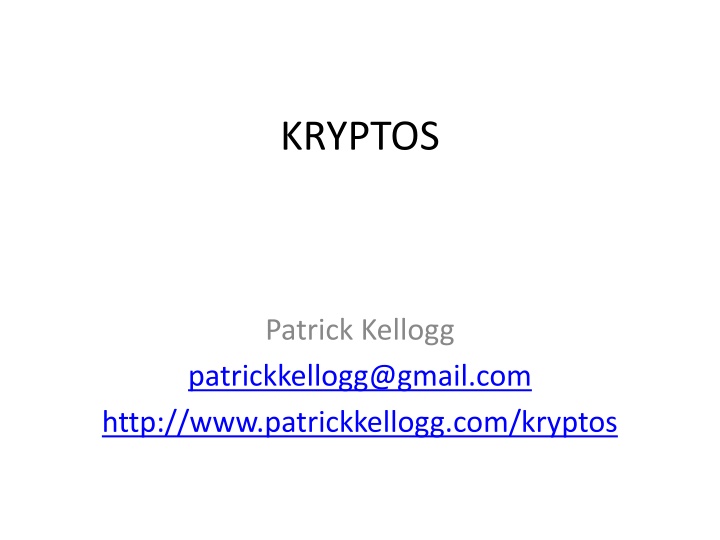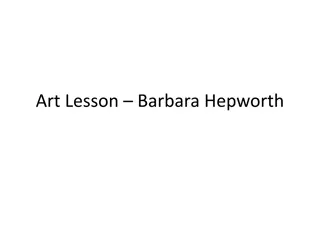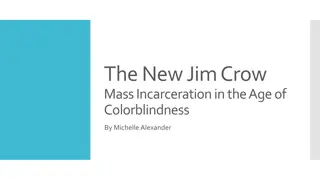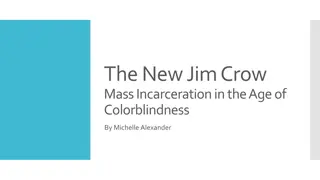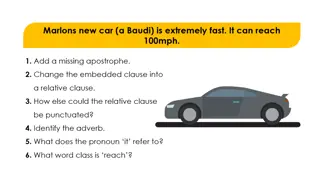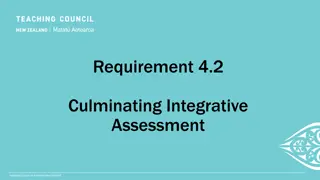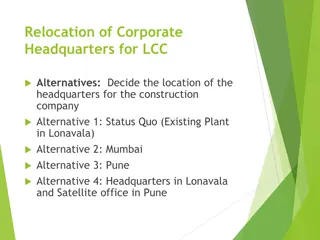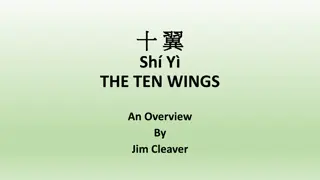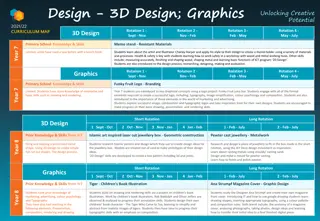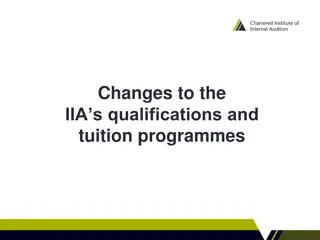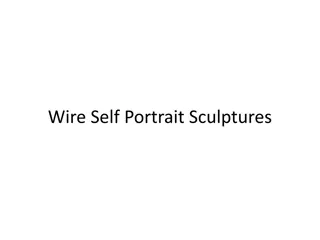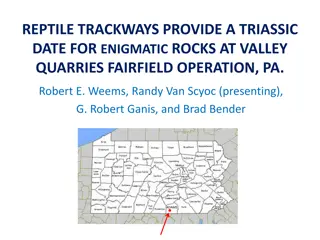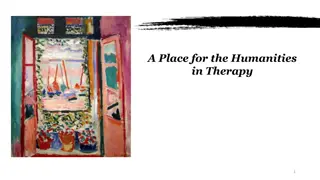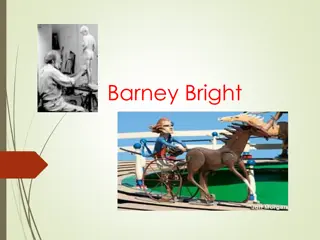The Enigmatic Kryptos Sculpture by Jim Sanborn at CIA Headquarters
The Kryptos sculpture created by artist Jim Sanborn in 1990 stands on the grounds of the CIA headquarters in Langley, Virginia. It features a metal wall adorned with encrypted text, benches, a fish pond, and other intriguing elements. Collaborating with NSA cryptographer Ed Scheidt, Sanborn incorporated Morse code and enigmatic messages, challenging viewers to decode its mysteries. The sculpture continues to captivate and intrigue visitors with its cryptic nature and historical significance.
Download Presentation

Please find below an Image/Link to download the presentation.
The content on the website is provided AS IS for your information and personal use only. It may not be sold, licensed, or shared on other websites without obtaining consent from the author.If you encounter any issues during the download, it is possible that the publisher has removed the file from their server.
You are allowed to download the files provided on this website for personal or commercial use, subject to the condition that they are used lawfully. All files are the property of their respective owners.
The content on the website is provided AS IS for your information and personal use only. It may not be sold, licensed, or shared on other websites without obtaining consent from the author.
E N D
Presentation Transcript
KRYPTOS Patrick Kellogg patrickkellogg@gmail.com http://www.patrickkellogg.com/kryptos
I love this sculpture by Jim Sanborn (Note: tiny reproduction)
About Kryptos The sculpture was erected in 1990 on the grounds of the CIA headquarters in Langley, Virginia The main part of the sculpture is a curved metal wall standing about 12 feet high There are also several benches, a fish pond, a magnetic lodestone, a compass, and many copper plates embossed with Morse code Sanborn worked with NSA cryptographer Ed Scheidt to understand the algorithms used
(Note: not my photo. This is from Wikipedia, and taken was provided by the artist Jim Sanborn)
The sculpture has encrypted text on the left side, and a Vigen re table on the right EMUFPHZLRFAXYUSDJKZLDKRNSHGNFIVJ YQTQUXQBQVYUVLLTREVJYQTMKYRDMFD VFPJUDEEHZWETZYVGWHKKQETGFQJNCE GGWHKK?DQMCPFQZDQMMIAGPFXHQRLG TIMVMZJANQLVKQEDAGDVFRPJUNGEUNA QZGZLECGYUXUEENJTBJLBQCRTBJDFHRR YIZETKZEMVDUFKSJHKFWHKUWQLSZFTI HHDDDUVH?DWKBFUFPWNTDFIYCUQZERE EVLDKFEZMOQQJLTTUGSYQPFEUNLAVIDX FLGGTEZ?FKZBSFDQVGOGIPUFXHHDRKF FHQNTGPUAECNUVPDJMQCLQUMUNEDFQ ELZZVRRGKFFVOEEXBDMVPNFQXEZLGRE DNQFMPNZGLFLPMRJQYALMGNUVPDXVKP DQUMEBEDMHDAFMJGZNUPLGEWJLLAETG ABCDEFGHIJKLMNOPQRSTUVWXYZABCD AKRYPTOSABCDEFGHIJLMNQUVWXZKRYP BRYPTOSABCDEFGHIJLMNQUVWXZKRYPT CYPTOSABCDEFGHIJLMNQUVWXZKRYPTO DPTOSABCDEFGHIJLMNQUVWXZKRYPTOS ETOSABCDEFGHIJLMNQUVWXZKRYPTOSA FOSABCDEFGHIJLMNQUVWXZKRYPTOSAB GSABCDEFGHIJLMNQUVWXZKRYPTOSABC HABCDEFGHIJLMNQUVWXZKRYPTOSABCD IBCDEFGHIJLMNQUVWXZKRYPTOSABCDE JCDEFGHIJLMNQUVWXZKRYPTOSABCDEF KDEFGHIJLMNQUVWXZKRYPTOSABCDEFG LEFGHIJLMNQUVWXZKRYPTOSABCDEFGH MFGHIJLMNQUVWXZKRYPTOSABCDEFGHI ENDYAHROHNLSRHEOCPTEOIBIDYSHNAIA CHTNREYULDSLLSLLNOHSNOSMRWXMNE TPRNGATIHNRARPESLNNELEBLPIIACAE WMTWNDITEENRAHCTENEUDRETNHAEOE TFOLSEDTIWENHAEIOYTEYQHEENCTAYCR EIFTBRSPAMHHEWENATAMATEGYEERLB TEEFOASFIOTUETUAEOTOARMAEERTNRTI BSEDDNIAAHTTMSTEWPIEROAGRIEWFEB AECTDDHILCEIHSITEGOEAOSDDRYDLORIT RKLMLEHAGTDHARDPNEOHMGFMFEUHE ECDMRIPFEIMEHNLSSTTRTVDOHW?OBKR UOXOGHULBSOLIFBBWFLRVQQPRNGKSSO TWTQSJQSSEKZZWATJKLUDIAWINFBNYP VTTMZFPKWGDKZXTJCDIGKUHUAUEKCAR NGHIJLMNQUVWXZKRYPTOSABCDEFGHIJL OHIJLMNQUVWXZKRYPTOSABCDEFGHIJL PIJLMNQUVWXZKRYPTOSABCDEFGHIJLM QJLMNQUVWXZKRYPTOSABCDEFGHIJLMN RLMNQUVWXZKRYPTOSABCDEFGHIJLMNQ SMNQUVWXZKRYPTOSABCDEFGHIJLMNQU TNQUVWXZKRYPTOSABCDEFGHIJLMNQUV UQUVWXZKRYPTOSABCDEFGHIJLMNQUVW VUVWXZKRYPTOSABCDEFGHIJLMNQUVWX WVWXZKRYPTOSABCDEFGHIJLMNQUVWXZ XWXZKRYPTOSABCDEFGHIJLMNQUVWXZK YXZKRYPTOSABCDEFGHIJLMNQUVWXZKR ZZKRYPTOSABCDEFGHIJLMNQUVWXZKRY ABCDEFGHIJKLMNOPQRSTUVWXYZABCD
There are actually four separate encrypted parts: the first three have been solved EMUFPHZLRFAXYUSDJKZLDKRNSHGNFIVJ YQTQUXQBQVYUVLLTREVJYQTMKYRDMFD VFPJUDEEHZWETZYVGWHKKQETGFQJNCE GGWHKK?DQMCPFQZDQMMIAGPFXHQRLG TIMVMZJANQLVKQEDAGDVFRPJUNGEUNA QZGZLECGYUXUEENJTBJLBQCRTBJDFHRR YIZETKZEMVDUFKSJHKFWHKUWQLSZFTI HHDDDUVH?DWKBFUFPWNTDFIYCUQZERE EVLDKFEZMOQQJLTTUGSYQPFEUNLAVIDX FLGGTEZ?FKZBSFDQVGOGIPUFXHHDRKF FHQNTGPUAECNUVPDJMQCLQUMUNEDFQ ELZZVRRGKFFVOEEXBDMVPNFQXEZLGRE DNQFMPNZGLFLPMRJQYALMGNUVPDXVKP DQUMEBEDMHDAFMJGZNUPLGEWJLLAETG ABCDEFGHIJKLMNOPQRSTUVWXYZABCD AKRYPTOSABCDEFGHIJLMNQUVWXZKRYP BRYPTOSABCDEFGHIJLMNQUVWXZKRYPT CYPTOSABCDEFGHIJLMNQUVWXZKRYPTO DPTOSABCDEFGHIJLMNQUVWXZKRYPTOS ETOSABCDEFGHIJLMNQUVWXZKRYPTOSA FOSABCDEFGHIJLMNQUVWXZKRYPTOSAB GSABCDEFGHIJLMNQUVWXZKRYPTOSABC HABCDEFGHIJLMNQUVWXZKRYPTOSABCD IBCDEFGHIJLMNQUVWXZKRYPTOSABCDE JCDEFGHIJLMNQUVWXZKRYPTOSABCDEF KDEFGHIJLMNQUVWXZKRYPTOSABCDEFG LEFGHIJLMNQUVWXZKRYPTOSABCDEFGH MFGHIJLMNQUVWXZKRYPTOSABCDEFGHI ENDYAHROHNLSRHEOCPTEOIBIDYSHNAIA CHTNREYULDSLLSLLNOHSNOSMRWXMNE TPRNGATIHNRARPESLNNELEBLPIIACAE WMTWNDITEENRAHCTENEUDRETNHAEOE TFOLSEDTIWENHAEIOYTEYQHEENCTAYCR EIFTBRSPAMHHEWENATAMATEGYEERLB TEEFOASFIOTUETUAEOTOARMAEERTNRTI BSEDDNIAAHTTMSTEWPIEROAGRIEWFEB AECTDDHILCEIHSITEGOEAOSDDRYDLORIT RKLMLEHAGTDHARDPNEOHMGFMFEUHE ECDMRIPFEIMEHNLSSTTRTVDOHW?OBKR UOXOGHULBSOLIFBBWFLRVQQPRNGKSSO TWTQSJQSSEKZZWATJKLUDIAWINFBNYP VTTMZFPKWGDKZXTJCDIGKUHUAUEKCAR NGHIJLMNQUVWXZKRYPTOSABCDEFGHIJL OHIJLMNQUVWXZKRYPTOSABCDEFGHIJL PIJLMNQUVWXZKRYPTOSABCDEFGHIJLM QJLMNQUVWXZKRYPTOSABCDEFGHIJLMN RLMNQUVWXZKRYPTOSABCDEFGHIJLMNQ SMNQUVWXZKRYPTOSABCDEFGHIJLMNQU TNQUVWXZKRYPTOSABCDEFGHIJLMNQUV UQUVWXZKRYPTOSABCDEFGHIJLMNQUVW VUVWXZKRYPTOSABCDEFGHIJLMNQUVWX WVWXZKRYPTOSABCDEFGHIJLMNQUVWXZ XWXZKRYPTOSABCDEFGHIJLMNQUVWXZK YXZKRYPTOSABCDEFGHIJLMNQUVWXZKR ZZKRYPTOSABCDEFGHIJLMNQUVWXZKRY ABCDEFGHIJKLMNOPQRSTUVWXYZABCD
The fourth part is still unencrypted! Despite many attempts over the last 25 years, no one knows what the last part of the message means, or if it ties the message of the whole sculpture together.
K1 Information The four parts of the sculpture have been referred to as K1, K2, K3, and K4 K1 and K2 were first solved publicly in 1999 by computer scientist Jim Gillogly (Though supposedly the NSA solved it in three days)
K1 Solution K1 is a simple Vigen re substitution The keyword for K1 is PALIMPSEST And the plaintext for K1 turns out to be: BETWEEN SUBTLE SHADING AND THE ABSENCE OF LIGHT LIES THE NUANCE OF IQLUSION
Weird Things About K1 Sanborn intentionally misspelled the word IQLUSION , which is a traditional method of making decryption more difficult The word PALIMPSEST means a manuscript page, either from a scroll or a book, from which the text has been scraped or washed off so that the page can be reused for another document , which may have artistic meaning for the artist
More Weird Things About K1 Note that the Vigen re used to solve K1 is not the one on the right side of the sculpture! Instead, Sanborn uses a variant of Vigen re called a Quagmire III which requires both an Alphabet Key at the top of the table, and a repeated Passphrase Alphabet key = KRYPTOS Passphrase = PALIMPSEST
Setting Up The Quagmire III First, take the standard alphabet and pull the non-repeating letters of the Alphabet Key out and stick them at the front KRYPTOSABCDEFGHIJLMNQUVWXZ Then, add rows corresponding with the Passphrase. For example, the first P row starts with PTOSABC
Warning: Actually Not A Vigenre However, Sanborn does something strange On the sculpture, he depicts a standard table. However, that is not the table he uses! First lines on the sculpture Actual substitution table
Sanborn Vigenre Vs. Quagmire III Both the column order AND the row orders are different. This will give you incorrect results if you try to use a traditional method! Standard Vigen re Sanborn s Table
Lets Solve K1! EMUFPHZLRFAXYUSDJKZLDKRNSHGNFIVJ YQTQUXQBQVYUVLLTREVJYQTMKYRDMFD So, the first two decrypted letters are BE The next are TWEE
More About K1 BETWEEN SUBTLE SHADING AND THE ABSENCE OF LIGHT LIES THE NUANCE OF IQLUSION This is a poetic phrase made up by Jim Sanborn Maybe it refers to the nearby sundial? Or perhaps Sanborn is talking about the way the sun shines THROUGH the cut-out letters of the sculpture to cast a message on the world below
Lets Solve K2! K2 was solved similarly using the keyword ABSCISSA
Lets Solve K2! The decrypted message is: IT WAS TOTALLY INVISIBLE HOWS THAT POSSIBLE ? THEY USED THE EARTHS MAGNETIC FIELD X THE INFORMATION WAS GATHERED AND TRANSMITTED UNDERGRUUND TO AN UNKNOWN LOCATION X DOES LANGLEY KNOW ABOUT THIS ? THEY SHOULD ITS BURIED OUT THERE SOMEWHERE X WHO KNOWS THE EXACT LOCATION ? ONLY WW THIS WAS HIS LAST MESSAGE X THIRTY EIGHT DEGREES FIFTY SEVEN MINUTES SIX POINT FIVE SECONDS NORTH SEVENTY SEVEN DEGREES EIGHT MINUTES FORTY FOUR SECONDS WEST X LAYER TWO
K2 Meaning This is another original message by Sanborn The geographic coordinates mentioned in the message correspond roughly to the location of the sculpture itself (about 100 feet southeast) No, the CIA won t let you into the courtyard in order to dig around to see what you find
Weird things about K2 Again, there is a misspelled word (UNDERGRUUND) In addition, K2 is the only part of the sculpture that contains punctuation (i.e. question marks). Traditionally, these are taken out before encryption
Who is WW? WW stands for William Webster, who was the Director of the CIA at the time that Kryptos was installed At the 1990 dedication ceremony of Kryptos, Sanborn gave a sealed envelope to Webster, which reportedly contained the solution However, in a 2005 interview with Wired magazine, Sanborn said that Scheidt and Webster only thought they knew the solution. In fact, he had deceived them.
More About K2 The word ABSCISSA means: the number whose absolute value (modulus) is the perpendicular distance of a point from the vertical axis For example, below the abscissa is 3 and the ordinate is 5 Maybe, like PALIMPSEST, this word has special meaning to the artist
Huge Mistake In K2 The first people to solve K2 decrypted the final line to be: ...FOUR SECONDS WEST ID BY ROWS However, this was wrong. It should have been ...FOUR SECONDS WEST X LAYER TWO Sanborn made a terrible mistake when manufacturing the sculpture. He took the line PLGEXWJLLAETG and bizarrely removed the the X thinking it was not needed. Of course, this dramatically changes the plaintext. If you randomly delete a letter in an encrypted Vigen re, all letters after it will be incorrect. It s amazing that the rest of the message after the X made any sense!
K3 The third part of the sculpture is completely different! Unlike K1 and K3, it is not a Vigen re (nor a Quagmire III) Instead, the letters are rearranged according to a Transposition Cypher. No letter substitution is performed a Q in the cypher is a Q in the plaintext forever
Rearranging K3 (Step 1) First, put K3 into a 24 by 14 grid:
Rearranging K3 (Step 2) Then, rotate it clockwise 90 degrees:
Rearranging K3 (Step 3) Reformat the result into an 8 by grid:
Rearranging K3 (Step 4) Finally, rotate the grid 90 degrees CW again:
K3 Solution SLOWLY DESPARATLY SLOWLY THE REMAINS OF PASSAGE DEBRIS THAT ENCUMBERED THE LOWER PART OF THE DOORWAY WAS REMOVED WITH TREMBLING HANDS I MADE A TINY BREACH IN THE UPPER LEFT HAND CORNER AND THEN WIDENING THE HOLE A LITTLE I INSERTED THE CANDLE AND PEERED IN THE HOT AIR ESCAPING FROM THE CHAMBER CAUSED THE FLAME TO FLICKER BUT PRESENTLY DETAILS OF THE ROOM WITHIN EMERGED FROM THE MIST X CAN YOU SEE ANYTHING Q ?
More About K3 This plaintext is a description of what happened when King Tut s tomb was opened in 1922, according to Howard Carter s book The Tomb of Tutankhamun . Lord Carnarvon asked Carter if he saw anything peering into the tomb, and Q (Carter) famously responded, wonderful things ! Note the misspelling of DESPARATLY
How Did They Find The Solution? Supposedly, NSA cryptographer Dennis McDaniels discovered the rotation in six hours by just sitting on his couch and looking at it He said he noticed a Q in the encrypted text and tried to manipulate the columns until a U appeared next to the Q (However, that story can t be correct since there is on QU in the plaintext!)
How To Solve K4 Nobody has solved K4 as of today (January 2017) Jim Sanborn was getting flooded with so many questions (and incorrect answers) that he implemented a website that would automatically check submissions at: http://www.kryptosclue.com However, as of 2017, that website is down and not functioning. You can supposedly test your answer by submitting $50 money order to Sanborn at: kryptos@earthlink.net Perhaps Sanborn is getting sick of the whole thing
Is K4 A Simple Transposition? Maybe K4 uses the same encryption method as K3, the way K1 and K2 are both Vigen re? However, this is doubtful In English, the most frequently-used letters are: ETAOINSHRDLU However, for this message the most frequent are: K/STU/BO/AFGILQRWZ So, K4 is probably not a single transposition
Is K4 A Simple Vigenre? In 2006, Jim Sanborn gave a clue: The 64-69 letters in K4 are CLOCK And in 2014, he gave another clue: The 70-74 letters are BERLIN No one knows what a BERLINCLOCK is
Vigenre With BERLINCLOCK If we have the encrypted text and we know the solution plaintext, we can find the keyword! Meaning the keyword would be ELYOIECBAQK, which makes no sense and can t be right
Transposition AND A Vigenre My guess is that Sanborn used a transposition first (as in K3), and then did a substitution Vigen re (as in K1 and K2) Cracking a single Vigen re substitution is difficult. Decrypting a message that has used two (or more!) substitutions would be much worse. I am hoping that is not the case
Possible Method Of K4 Take a message Create an interesting way of mixing it up Perform a Vigen re, using a keyword (like SWAN )
Methods Of Transformation Jim Sanborn is an artist. As such, he may have invented a new type of route or path transformation that looked nice to him Until the answer is discovered, we will not know
97 Is Prime Unfortunately, 97 is a prime number. So, it can t be factored in the many ways that K3 could (at 336 = 24 x 14 characters) K4 can t be arranged geometrically easily 1+2+3+4+5+6+7+8+9+10+11+12+13=91 1+3+5+7+9+11+13+15+17=81 1+2+3+4+5+6+7+8+9+8+7+6+5+4+3+2+1=81 1+3+5+7+9+11+13+11+9+7+5+3+1=85
Random Transformation So, my idea is to: 1. Perform a random permutation on the 97 characters 2. Use the BERLINCLOCK crib to find eleven letters that may be part of a keyword 3. Use a dictionary lookup to see if any English word partially matches the keyword For example a partial decryption of BERLINCLOCK = KESLEAVIZLE might hint at a repeated keyword LEAVESLEAVESLEAVES
Example Of Method So, imagine that after shuffling all 97 letters of the encrypted text randomly, the 64ththrough 74thletters happen to be: BVABKKOSTKE Then, do a reverse Sanborn s Vigen re to find eleven keyword letters of KESLEAVIZLE A dictionary lookup suggests the keyword is LEAVES (repeated as LEAVESLEAVESLEAVES)
Python Code An implementation in Python can be found at: https://github.com/patrickkellogg/Kryptos Currently, the output states: 1. How many of the 11 letters match the keyword 2. The original encrypted 97 characters with the 11 chosen crib characters in UPPER CASE
Code Results 3. Groupit , the 11 randomly shuffled encrypted letters that make up the BERLINCLOCK crib 4. Segment , the 11 possible keyword letters 5. The keyword chosen from a dictionary lookup 6. The fully decrypted string using the keyword 7. And finally, a FFT (described on next page)
Fast Fourier Transform (FFT) If I have a good keyword candidate, I can see the locations of where chosen 11 crib letters came from In this example, every third letter seems to be randomly chosen to be part of the 11 letters This is turned into a Python array like this: [0,0,1,0,0,1,0,0,1,0,0,1,0,0,1
FFT Period Estimate Once I have a Python array of ones and zeros, I do a FFT on the data, and plot the results
FFT Strength Or, I could have done an autocorrelation. Both methods find repetitions in the data This keyword PSALMODIAL only has a Strength of 7.8, where better candidates are closer to 10. This keyword is probably not correct
More On The FFT I can also find the peak of the largest possible frequency component. For example, might suggest a folding of every third letter This would be helpful in the future to try and figure out if and how Sanborn is perform a transformation.
My Word List Here are some possible keywords that my code has found:
Other Kryptos Errors There are several other strange things about the Kryptos sculpture: The Vigen re table on sculpture (which, as stated, earlier, is not even used correctly by Sanborn for the encryption) has a bad line on the top line of the bottom-right quadrant NGHIJL with one too many L characters at the end For some reason, in the bottom-left quadrant, three of the first few letters are raised above the others (the YA R in ENDYAHR) Some people have thought K4 contains an error and that s why it s difficult to crack, but in 2003 Sanborn said, Yes. It ain't easy, but it's solvable!
